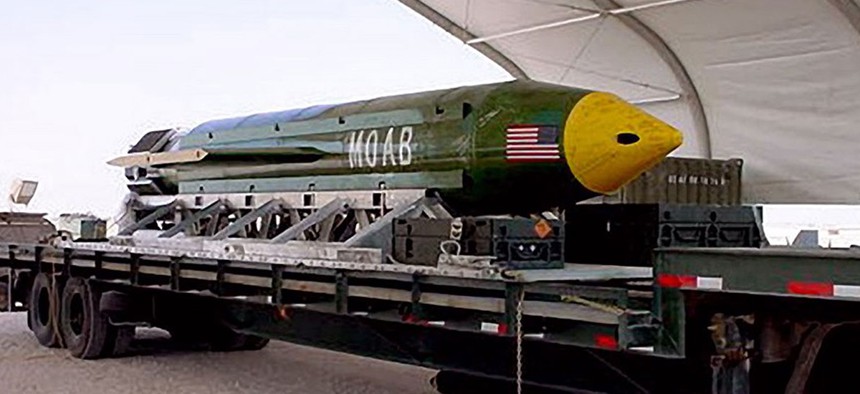
Air Force file photo
The US just stepped up its anti-ISIL operations in Afghanistan, dropping the GBU-43, known as the “Mother of All Bombs” (MOAB), on a tunnel complex in the east of the country—the biggest non-nuclear bomb ever dropped in combat by the US.
Here’s what we know about the bomb and the bombing:
Size and Power
- The GBU-43 has the force of 11 kilotons of TNT, an explosive output just short of the 15-kiloton nuclear bomb dropped on Hiroshima in 1945. The bomb dropped days later on Nagasaki was the equivalent of 20 kilotons.
- Officials were unsure if the 21,000-pound-MOAB is more powerful than the larger and heavier MOP (Massive Ordnance Penetrator), which weighs in at 30,000 pounds. The MOP has yet to be used.
- When the MOAB was first tested in March 2003, a mushroom cloud could be seen from a distance of 20 miles, according to the Air Force Print News service.
- The bomb, carried by a large transport plane, is more than 30 feet long, Politico reports.
History
- The MOAB was originally built in 2003, during the Iraq war ,to intimidate Saddam Hussein, according to the AFPN, though it was never deployed in Iraq. “The goal is to have the pressure be so great that Saddam Hussein cooperates,” then-defense secretary Donald Rumsfeld said in March 2003. “Short of that…the goal is to have the capabilities of the coalition so clear and so obvious that there is an enormous disincentive for the Iraqi military to fight against the coalition.”
- It was designed in such a hurry that they had no choice of what color to paint it, munitions design chief Robert Hammack told AFPN in 2008. “Since we were in such a rush to get the weapon into our inventory to send over to aid the war effort, resources were limited. The weekend the MOAB arrived, the only color available in the amount we needed was John Deere green.”
- Each unit costs $16 million and the army has spent a total $314 million on them, according to military website Deagel.
Use and the results
- Officials could not immediately assess the level of damage but said its deployment was aimed at minimizing impact on US and Afghan soldiers. It is guided by a GPS system that allows it to move accurately to within 8 meters of its intended impact point, an air force official said.
- It is particularly adept at penetrating caves and canyons, and clearing minefields, the official said. This means it was well-placed to hit the bunkers and tunnels that ISIL have been using in Afghanistan—it was dropped at just such a tunnel complex in Achin district, Nangarhar province.






